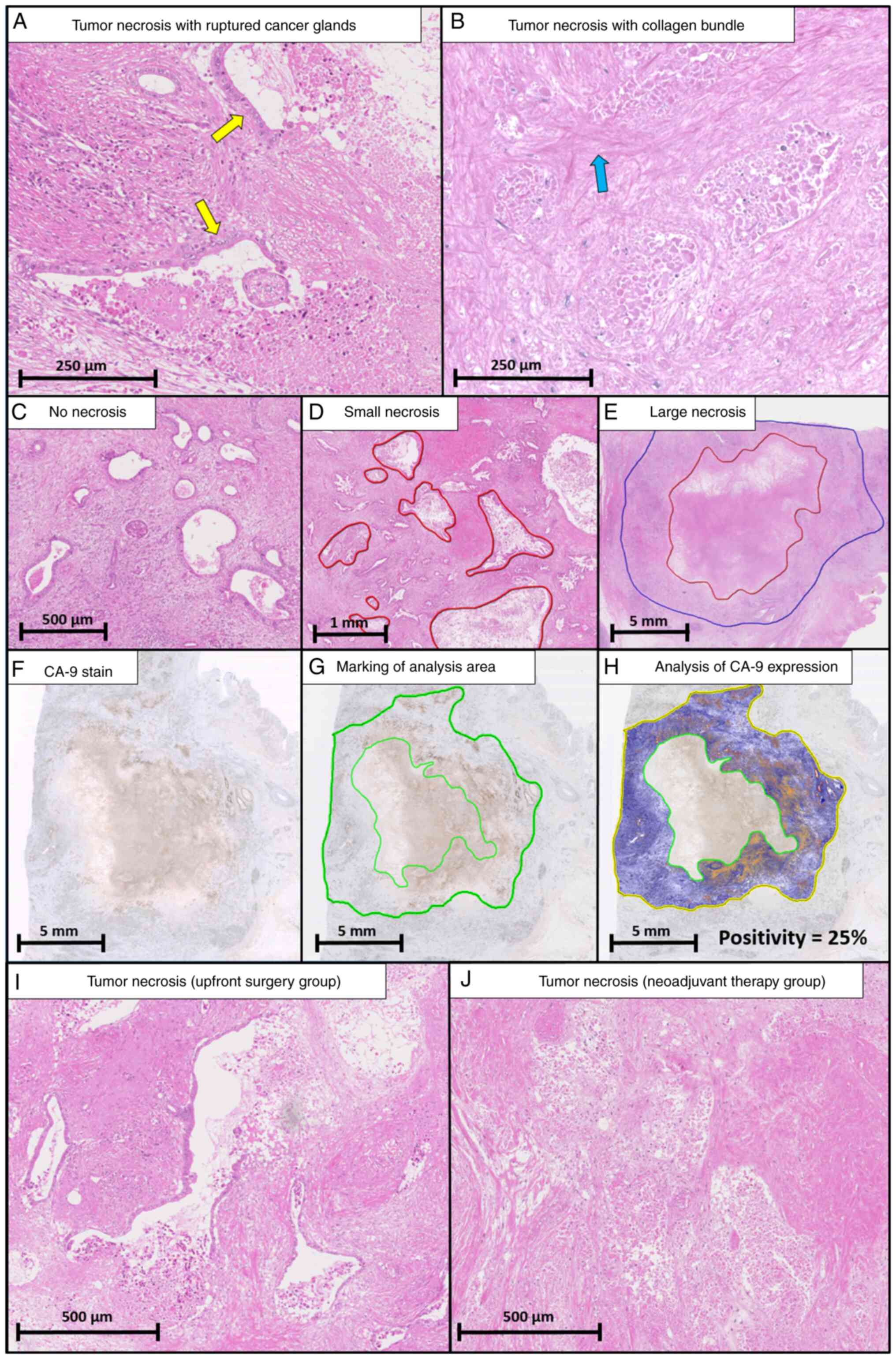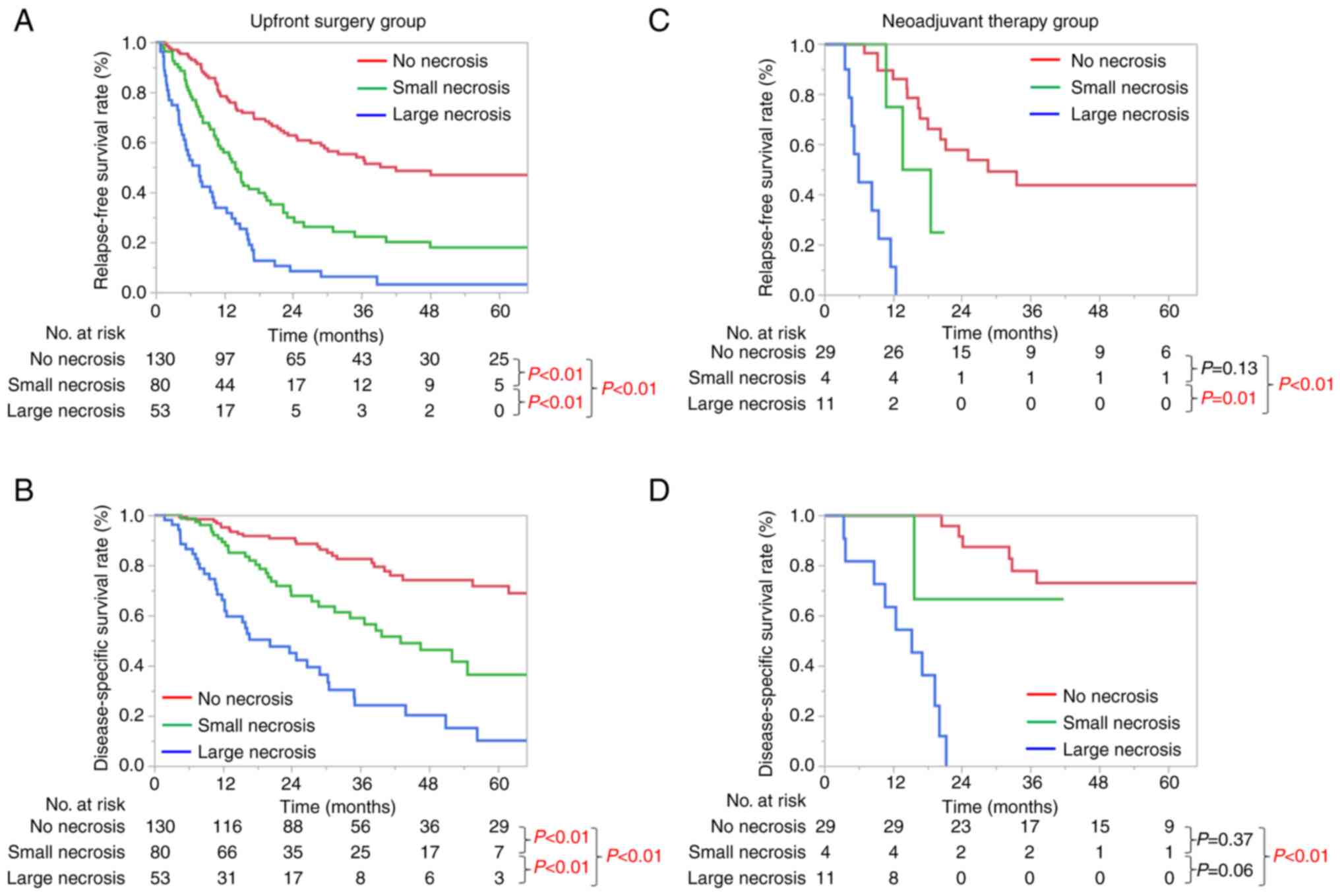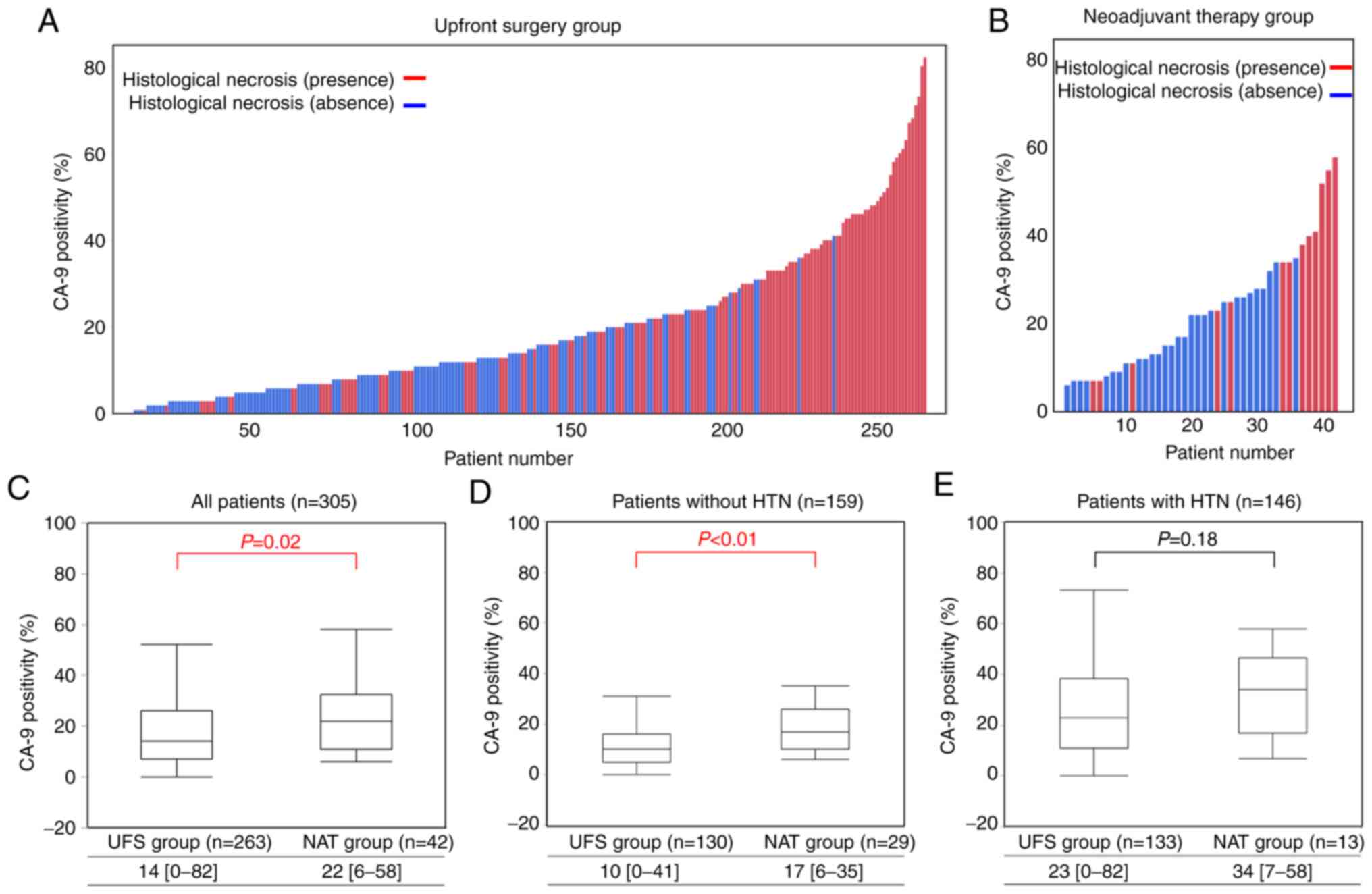|
1
|
Siegel RL, Miller KD and Jemal A: Cancer
statistics, 2018. CA Cancer J Clin. 68:7–30. 2018. View Article : Google Scholar : PubMed/NCBI
|
|
2
|
Zhan HX, Xu JW, Wu D, Wu ZY, Wang L, Hu SY
and Zhang GY: Neoadjuvant therapy in pancreatic cancer: A
systematic review and meta-analysis of prospective studies. Cancer
Med. 6:1201–1219. 2017. View Article : Google Scholar : PubMed/NCBI
|
|
3
|
Sugimoto M, Takahashi N, Farnell MB, Smyrk
TC, Truty MJ, Nagorney DM, Smoot RL, Chari ST, Carter RE and
Kendrick ML: Survival benefit of neoadjuvant therapy in patients
with non-metastatic pancreatic ductal adenocarcinoma: A propensity
matching and intention-to-treat analysis. J Surg Oncol.
120:976–984. 2019. View Article : Google Scholar
|
|
4
|
Unno M, Hata T and Motoi F: Long-term
outcome following neoadjuvant therapy for resectable and borderline
resectable pancreatic cancer compared to upfront surgery: A
meta-analysis of comparative studies by intention-to-treat
analysis. Surg Today. 49:295–299. 2019. View Article : Google Scholar : PubMed/NCBI
|
|
5
|
Kudo M, Kobayashi T, Gotohda N, Konishi M,
Takahashi S, Kobayashi S, Sugimoto M, Okubo S, Martin J, Cabral H,
et al: Clinical utility of histological and radiological
evaluations of tumor necrosis for predicting prognosis in
pancreatic cancer. Pancreas. 49:634–641. 2020. View Article : Google Scholar : PubMed/NCBI
|
|
6
|
Mitsunaga S, Hasebe T, Iwasaki M,
Kinoshita T, Ochiai A and Shimizu N: Important prognostic
histological parameters for patients with invasive ductal carcinoma
of the pancreas. Cancer Sci. 96:858–865. 2005. View Article : Google Scholar
|
|
7
|
Hiraoka N, Ino Y, Sekine S, Tsuda H,
Shimada K, Kosuge T, Zavada J, Yoshida M, Yamada K, Koyama T and
Kanai Y: Tumour necrosis is a postoperative prognostic marker for
pancreatic cancer patients with a high interobserver
reproducibility in histological evaluation. Br J Cancer.
103:1057–1065. 2010. View Article : Google Scholar : PubMed/NCBI
|
|
8
|
Okusaka T, Nakamura M, Yoshida M, Kitano
M, Uesaka K, Ito Y, Furuse J, Hanada K and Okazaki K: Clinical
practice guidelines for pancreatic cancer 2019 from the Japan
Pancreas Society: A synopsis. Pancreas. 49:326–335. 2020.
View Article : Google Scholar : PubMed/NCBI
|
|
9
|
Takahashi S: How to treat borderline
resectable pancreatic cancer: Current challenges and future
directions. Jpn J Clin Oncol. 48:205–213. 2018. View Article : Google Scholar
|
|
10
|
Motoi F, Kosuge T, Ueno H, Yamaue H, Satoi
S, Sho M, Honda G, Matsumoto I, Wada K, Furuse J, et al: Randomized
phase II/III trial of neoadjuvant chemotherapy with gemcitabine and
S-1 versus upfront surgery for resectable pancreatic cancer
(Prep-02/JSAP05). Jpn J Clin Oncol. 49:190–194. 2019. View Article : Google Scholar
|
|
11
|
Takahashi S, Ohno I, Ikeda M, Kobayashi T,
Akimoto T, Kojima M, Konishi M and Uesaka K: Neoadjuvant S-1 with
concurrent radiotherapy followed by surgery for borderline
resectable pancreatic cancer: Study protocol for an open-label,
multicentre, prospective phase II trial (JASPAC05). BMJ Open.
7:e0184452017.PubMed/NCBI
|
|
12
|
Takahashi S, Ohno I, Ikeda M, Konishi M,
Kobayashi T, Akimoto T, Kojima M, Morinaga S, Toyama H, Shimizu Y,
et al: Neoadjuvant S-1 with concurrent radiotherapy followed by
surgery for borderline resectable pancreatic cancer: A phase II
open-label multicenter prospective trial (JASPAC05). Ann Surg. Oct
15–2020.(Epub ahead of print). doi: 10.1097/SLA.0000000000004535.
View Article : Google Scholar
|
|
13
|
Okubo S, Kojima M, Matsuda Y, Hioki M,
Shimizu Y, Toyama H, Morinaga S, Gotohda N, Uesaka K, Ishii G, et
al: Area of residual tumor (ART) can predict prognosis after post
neoadjuvant therapy resection for pancreatic ductal adenocarcinoma.
Sci Rep. 9:171452019. View Article : Google Scholar : PubMed/NCBI
|
|
14
|
Brierley JD, Gospodarowicz MK and
Wittekind C: TNM Classification of Malignant Tumours. John Wiley
and Sons; 2017
|
|
15
|
N Kalimuthu S, Serra S, Dhani N,
Hafezi-Bakhtiari S, Szentgyorgyi E, Vajpeyi R and Chetty R:
Regression grading in neoadjuvant treated pancreatic cancer: An
interobserver study. J Clin Pathol. 70:237–243. 2017. View Article : Google Scholar
|
|
16
|
Evans DB, Rich TA, Byrd DR, Cleary KR,
Connelly JH, Levin B, Charnsangavej C, Fenoglio CJ and Ames FC:
Preoperative chemoradiation and pancreaticoduodenectomy for
adenocarcinoma of the pancreas. Arch Surg. 127:1335–1339. 1992.
View Article : Google Scholar : PubMed/NCBI
|
|
17
|
Aperio Positive Pixel Count Algorithm.
Journal. 2020.
|
|
18
|
Mirkin KA, Greenleaf EK, Hollenbeak CS and
Wong J: Correlation of clinical and pathological staging and
response to neoadjuvant therapy in resected pancreatic cancer. Int
J Surg. 52:221–228. 2018. View Article : Google Scholar : PubMed/NCBI
|
|
19
|
Sakuyama N, Kojima M, Kawano S, Matsuda Y,
Mino-Kenudson M, Ochiai A and Ito M: Area of residual tumor is a
robust prognostic marker for patients with rectal cancer undergoing
preoperative therapy. Cancer Sci. 109:871–878. 2018. View Article : Google Scholar
|
|
20
|
Kawai M, Hirono S, Okada KI, Miyazawa M,
Shimizu A, Kitahata Y, Kobayashi R, Ueno M, Hayami S, Tanioka K and
Yamaue H: Low lymphocyte monocyte ratio after neoadjuvant therapy
predicts poor survival after pancreatectomy in patients with
borderline resectable pancreatic cancer. Surgery. 165:1151–1160.
2019. View Article : Google Scholar : PubMed/NCBI
|
|
21
|
Lei MZ, Li XX, Zhang Y, Li JT, Zhang F,
Wang YP, Yin M, Qu J and Lei QY: Acetylation promotes BCAT2
degradation to suppress BCAA catabolism and pancreatic cancer
growth. Signal Transduct Target Ther. 5:702020. View Article : Google Scholar : PubMed/NCBI
|
|
22
|
Zheng Y, Wu C, Yang J, Zhao Y, Jia H, Xue
M, Xu D, Yang F, Fu D, Wang C, et al: Insulin-like growth factor
1-induced enolase 2 deacetylation by HDAC3 promotes metastasis of
pancreatic cancer. Signal Transduct Target Ther. 5:532020.
View Article : Google Scholar : PubMed/NCBI
|
|
23
|
Arora S, Bhardwaj A, Singh S, Srivastava
SK, McClellan S, Nirodi CS, Piazza GA, Grizzle WE, Owen LB and
Singh AP: An undesired effect of chemotherapy: Gemcitabine promotes
pancreatic cancer cell invasiveness through reactive oxygen
species-dependent, nuclear factor κB- and hypoxia-inducible factor
1α-mediated up-regulation of CXCR4. J Biol Chem. 288:21197–21207.
2013. View Article : Google Scholar : PubMed/NCBI
|
|
24
|
Däster S, Amatruda N, Calabrese D, Ivanek
R, Turrini E, Droeser RA, Zajac P, Fimognari C, Spagnoli GC, Iezzi
G, et al: Induction of hypoxia and necrosis in multicellular tumor
spheroids is associated with resistance to chemotherapy treatment.
Oncotarget. 8:1725–1736. 2017. View Article : Google Scholar
|
|
25
|
Hoang NT, Kadonosono T, Kuchimaru T and
Kizaka-Kondoh S: Hypoxia-inducible factor-targeting prodrug TOP3
combined with gemcitabine or TS-1 improves pancreatic cancer
survival in an orthotopic model. Cancer Sci. 107:1151–1158. 2016.
View Article : Google Scholar
|
|
26
|
Shannon AM, Bouchier-Hayes DJ, Condron CM
and Toomey D: Tumour hypoxia, chemotherapeutic resistance and
hypoxia-related therapies. Cancer Treat Rev. 29:297–307. 2003.
View Article : Google Scholar : PubMed/NCBI
|
|
27
|
Chauhan VP, Martin JD, Liu H, Lacorre DA,
Jain SR, Kozin SV, Stylianopoulos T, Mousa AS, Han X,
Adstamongkonkul P, et al: Angiotensin inhibition enhances drug
delivery and potentiates chemotherapy by decompressing tumour blood
vessels. Nat Commun. 4:25162013. View Article : Google Scholar : PubMed/NCBI
|

















